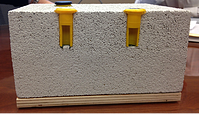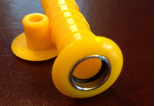Whenever there’s a discussion about measuring relative humidity (%RH) in concrete floors, the question of accuracy is often brought up. It’s always wise to get accurate moisture readings as there are many reasons for measuring RH, including:
-
Certification of the RH under a commercial contract (which is frequently verified by independent third-party inspectors)
-
To abide by the guidelines issued by manufacturer of the floor covering or adhesive
-
Compliance with certain materials warranties (which could be voided if specific RH levels are not maintained)
-
Simply to check that the moisture in the concrete has equalized or reached the level of stability needed to for construction to continue
Why is Proof Needed?
With the increasing focus on litigation, the issue of accuracy has become far more important in today’s society. No longer is it simply a matter of your reputation for good workmanship, today It’s all about getting down to proof! This means:
-
Proof that RH tests were properly completed and recorded
-
Proof that RH meter/sensor system is properly maintained and calibrated
-
Proof that tests were completed in compliance with a standard (such as ASTM F2170)
-
Proof the test sites were properly installed and protected so the RH readings were accurate
Every manufacturer has different equipment designs and recommendations for how the actual tests are performed with their equipment. No matter these methods, in the end, the results should be comparable across ALL manufacturers under the same conditions. So understanding the equipment and testing procedures is the user’s responsibility.
Testing moisture in concrete floors and slabs has become a bigger responsibility since the introduction of standards like ASTM F2170 over 10 years ago. The reason is because one day — maybe as early as next week or as distant as next decade — someone may ask you to prove that your RH tests were accurate and executed according to the standard.
There are many places where just the slightest user error or defect can have a significant impact on the outcome of that inquiry.
Just recently, we were reviewing a free RH testing training material on YouTube on how to install RH measurement sleeves into concrete. Surprisingly, a number of the postings were inaccurate or incomplete.
Unwitting contractors or inspectors who used this resource could easily measure a false positive or negative. Worse yet, they would be doomed if called upon to “prove” the test was done correctly. This outcome is NOT acceptable. Fortunately, it’s not difficult to come to an accurate measurement the first time.
Below, we’ve outlined 10 simple ways to comply to the ASTM F2170 standards for accurate concrete RH readings.

- When installing testing sleeves, you must first drill to the proper depth.
- After drilling a hole, vacuum the debris and inspect it so there’s NO excess dust or metal particle contaminants from reinforcement products. Contaminants and dust interfere with sensor performance. Vacuuming is required under ASTM F2170 guidelines.
- Use the right sleeve for the location. Flush sleeves are less prone to damage or interference at an active worksite.
- Ensure the sleeve has a tight fit so that humidity doesn’t escape the hole. The sleeve should be snug at the sides. Seal the tubes flange at the top of the sleeve with silicon as it’s being inserted into the cleaned drill hole is recommended. Sealing is required under ASTM F2170.
- Use clean caps on the sleeve and make sure they have a snug fit so humidity cannot escape and air cannot infiltrate.

- In indoor applications, check the condition of the sensor that’s providing the RH reading to make sure it’s not being contaminated by moisture off gassing.
- Regularly check your device and sensor for contaminants, abrasion or anything that may affect your readings.
- ALWAYS follow the maintenance and calibration protocols for the RH meter you’re using.
- ALWAYS check with the device manufacturer’s tech support if you have any questions about your readings or equipment.
- Photograph and record the dates, times and testing conditions. Then “file” them with the project record.
Conclusion
Every situation is unique for RH readings in concrete flooring and slabs. Some readings and controls have to be more precise than others but accuracy is always important. Use common sense and consider:
-
Where the floor is located
-
For what is the intended use for the structure
-
Contractual requirements and specifications
-
Materials specifications for floor coverings and other materials
Operating environment for electrical equipment and controls
Ultimately, you need to be confident in the testing you’ve performed. By following these 10 easy steps, you should have no problem proving your accuracy should someone come calling in the future.
For more on how to ensure an accurate concrete RH reading, contact one of our specialists today!

Comments